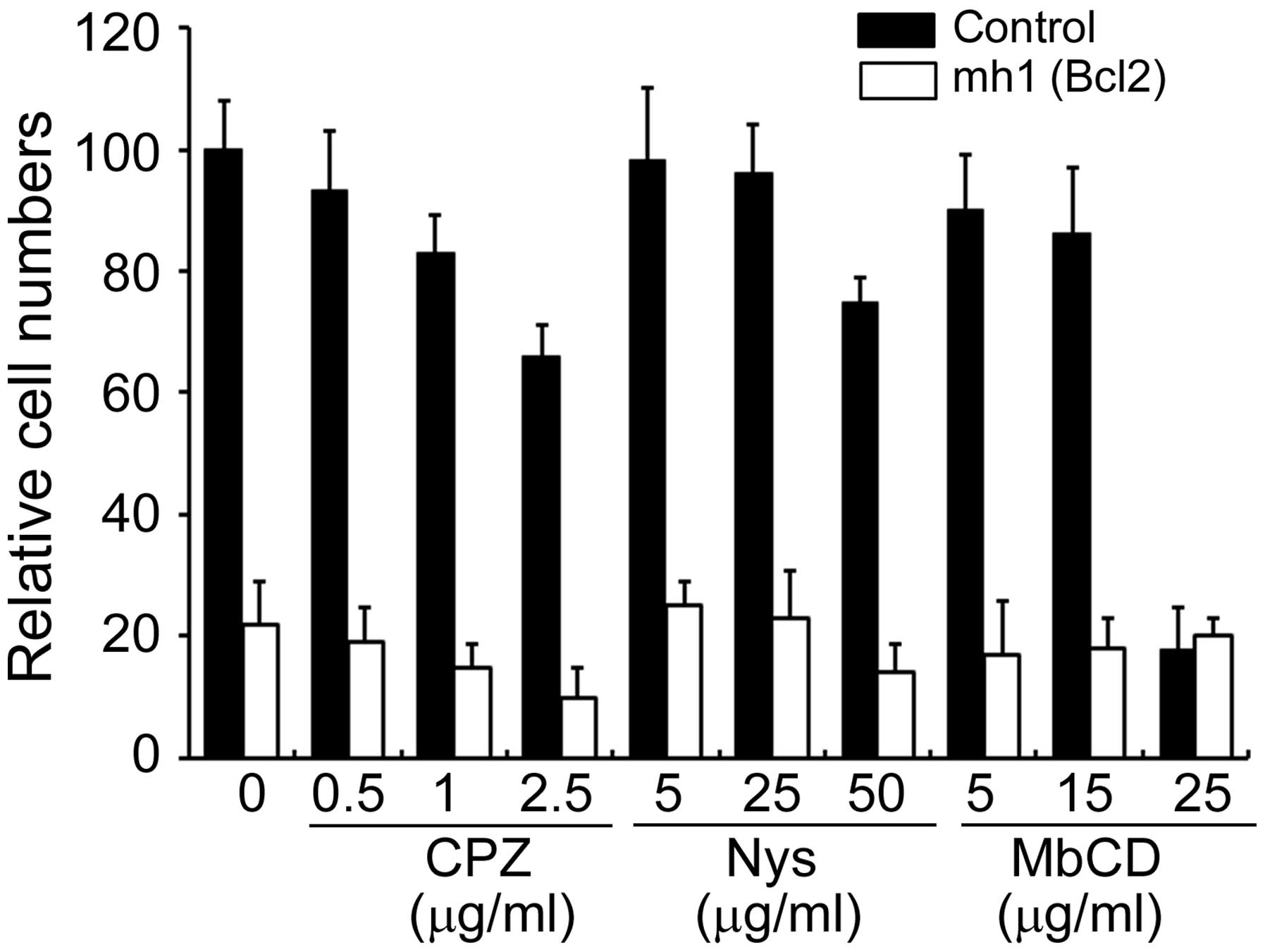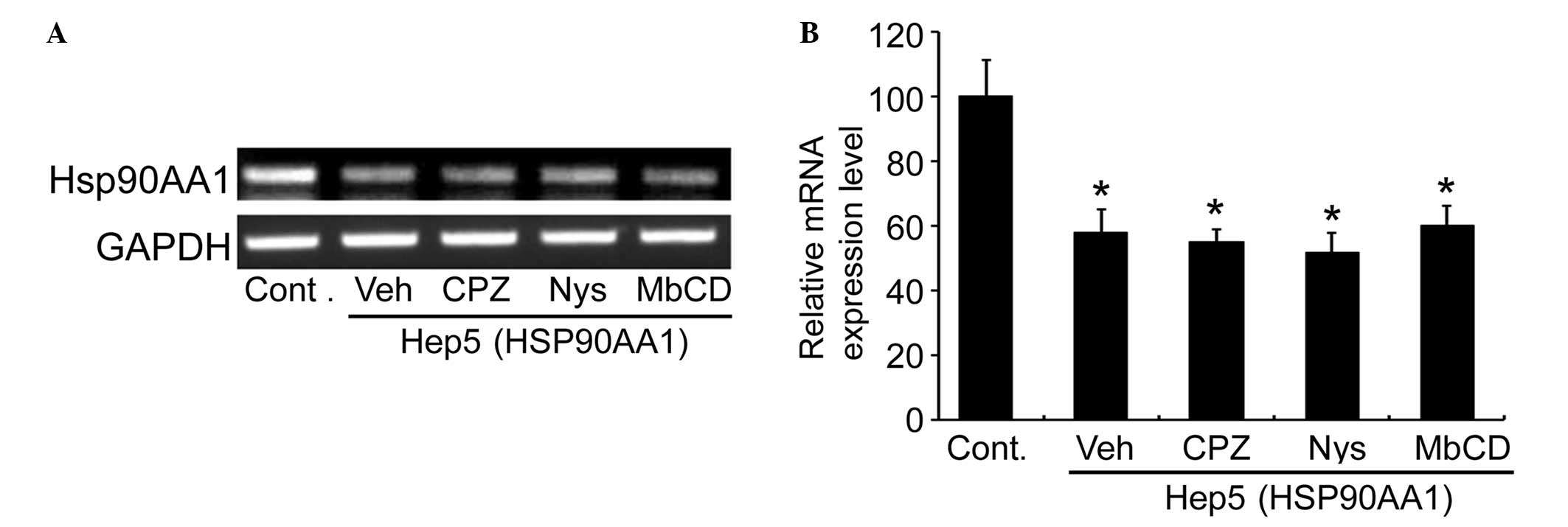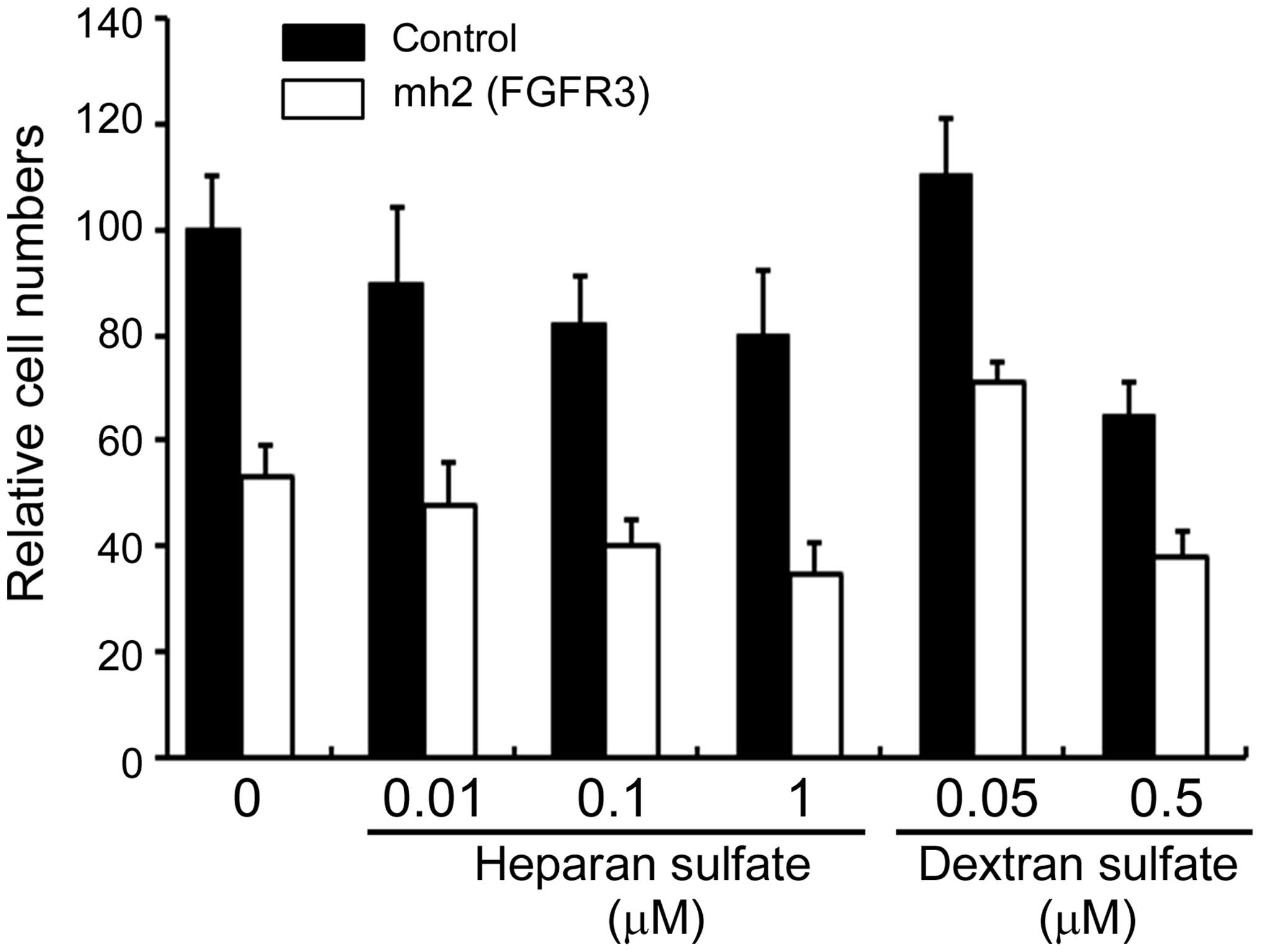Involvement of an intracellular vesicular transport process in naked-sgRNA-mediated TRUE gene silencing
- Authors:
- Published online on: July 31, 2015 https://doi.org/10.3892/mmr.2015.4160
- Pages: 6365-6369
Abstract
Introduction
tRNase ZL-utilizing efficacious gene silencing (TRUE gene silencing) is an RNA-mediated gene expression control technology with therapeutic potential (1–6). This technology is based on a unique enzymatic property of mammalian tRNase ZL, which is that it can cleave any target RNA at a desired site by recognizing a pre-tRNA-like or micro-pre-tRNA-like complex formed between the target RNA and an artificial small guide RNA (sgRNA).
The efficacy of TRUE gene silencing has been demonstrated by using it to introduce various artificially-designed sgRNAs into living cells either by their expression plasmids or by 2′-O-methyl RNAs (2,7). sgRNA is divided into four groups: 5′-half-tRNA, RNA heptamer, hook RNA and ~14-nt linear RNA (1,2,8,9). Linear-type sgRNAs can downregulate the expression of the human genes Bcl-2 and GSK-3β (7). Luciferase gene expression in mouse liver can be inhibited by a heptamer-type sgRNA (7). In addition, the efficacy of TRUE gene silencing can be compared with that of RNA interference technology (6–8). sgRNA can be easily taken up by cultured cells without any transfection reagents, and naked sgRNAs targeting Bcl-2 or WT1 mRNA can reduce the levels of mRNA and protein, as well as inducing the apoptosis of leukemia cells (9,10). However, little is known regarding the mechanism of naked sgRNA uptake into cultured cells. The 'gymnotic' mechanism (11–13) and/or the adaptor protein AP2M1 (14) are reported to be involved in the cellular uptake of naked oligonucleotides by cultured cells. In the present study, the effects of various inhibitors of apoptotic induction were investigated using naked sgRNA treatment in order to elucidate uptake pathways and mechanisms for sgRNA in cultured cells.
Materials and methods
RNA/DNA synthesis
The following 5′- and/or 3′-phosphorylated sgRNAs with full 2′-O-methyl modifications were chemically synthesized by Nippon Bioservice (Asaka, Saitama, Japan): mh1 (Bcl-2), 5′-pGGGCCAGp-3′; Luc-hep2, 5′-pGAUCGAG-3′; mh3 (EGFP), 5-pUUGCCGUp-3; Hep5 (HSP90AA1) 5′-pAGAUCCUp-3′; mh2 (FGFR3), 5′-pCCAGCACp-3′ (2,9,10). The DNA primers for polymerase chain reaction (PCR) were obtained from Hokkaido System Science (Sapporo, Japan).
Cell cultures
HL-60 or HEK-293 human cells were obtained from RIKEN BioResource Center (Tsukuba, Japan) and were cultured in RPMI-1640 medium (Sigma-Aldrich, St. Louis, MO, USA) or α-minima essential medium (MEM; Sigma-Aldrich) containing 100 µg/ml kanamycin (Meiji Seika Pharma International Ltd., Tokyo, Japan) and 10% fetal bovine serum (FBS; SAFC Biosciences, Inc. Lenexa, KS, USA) at 37°C in culture flasks or 100-mm culture dishes (Corning, Corning, NY, USA) in a humidified atmosphere of 5% CO2. The cells were incubated with medium containing chlorpromazine (CPZ), nystatin (Nys), methyl-β-cyclodextrin (MbCD), heparan sulfate, 10 K dextran sulfate, chloroquine, brefeldin A or none (vehicle group). The cells were cultured either with 1 µM naked 2′-O-methyl RNA or without naked 2′-O-methyl RNA (control cultures).
Compounds and reagents
CPZ, Nys, MbCD, heparan sulfate, 10 K dextran sulfate, chloroquine and brefeldin A were purchased from Sigma-Aldrich.
Quantitation of living cell numbers
HL-60 cells were seeded at a density of 1×103 cells/well in a 96-well plate in RPMI-1640 medium and were incubated for 30 min with medium containing CPZ, Nys, MbCD, heparan sulfate, 10 K dextran sulfate, chloroquine or brefeldin A, as appropriate, at the concentrations shown. The cells were cultured with 1 µM of naked 2′-O-methyl RNA; appropriate vehicle buffer was added to control cultures. After 3 days, to quantitate the number of living cells by the tetrazolium-based colorimetric MTT assay, 20 µl TetraColor ONE (Seikagaku Biobusiness Corp., Tokyo, Japan) was added to each well. After 2–4 h of incubation at 37°C, the optical density was measured at a wavelength of 450 nm using a microplate reader (iMark; Bio-Rad Laboratories, Inc., Hercules, CA, USA).
Reverse transcription-PCR (RT-PCR)
PCR was used to analyze the transcript levels of hsp90AA1. Total RNA was extracted from the cells at the indicated time points using Isogen (Nippongene, Toyama, Japan) and treated with RNase-free DNase (Qiagen, Hilden, Germany) to remove any contaminating genomic DNA. RT-PCR was performed as previously described (15). The primer sequences for each gene were as follows: hsp90AA1, 5′-TGCACCTTGGCTCTGTCTGAA-3′ (forward), 5′-CACCTGTTAACTGGTACCAAG-3′ (reverse); glyceraldehyde-3-phosphate dehydrogenase (GAPDH), 5′-TCCACCACCCTGTTGCTGTA-3′ (forward), 5′-ACCACAGTCCATGCCATCAC-3′ (reverse). To account for any difference in the quantity of RNA, GAPDH was selected as the endogenous control and amplified using the primers described above. The amplification products were electrophoresed on 2% agarose gels.
Quantitation of gene expression using reverse transcription-quantitative polymerase chain reaction (RT-qPCR)
RT-qPCR was performed using assay-on-demand TaqMan probes (Applied Biosystems, Foster City, CA, USA) and the StepOne® real time PCR system as previously described (16). The relative level of gene expression was quantified using the comparative Ct method with GAPDH as the endogenous control.
Statistical analysis
All experiments were repeated at least three times and representative results are shown. In the RT-qPCR analysis and the cell viability assay, differences between control and experimental groups are reported as the mean ± standard deviation, and were analyzed by Student's t-test, in which values of P<0.05 were considered to indicate a statistically significant difference.
Results and Discussion
To investigate the properties of heptamer-type sgRNA, our group designed a heptamer, mh1 (Bcl-2), targeting the human Bcl-2 mRNA (9). mh1 (Bcl-2) has the potential to bind Bcl-2 mRNA at four sites, each of which has an immediate upstream sequence that can form a hairpin structure resembling a T-arm of tRNA. As a result, a micro-pre-tRNA-like complex can be formed at each site, which acts as a substrate for tRNase ZL (2). It was identified that mh1 (Bcl-2) downregulated Bcl-2 mRNA compared with mock or mh3 (EGFP) sgRNA which have no potential target sites on Bcl-2 mRNA. This suggested that naked mh1 (Bcl-2) directs Bcl-2 mRNA cleavage by cellular tRNase ZL (9). First, the effects of fully synthesized 2′-O-methylated mh1 (Bcl-2) containing 5′ and 3′ phosphates were tested on living cell numbers by adding it to HL-60 cell culture medium without any transfection reagents. When 1 µM of naked mh1 (Bcl-2) was added to the culture medium, the living cell number reduced in 3 days compared with cultures without sgRNA (9). By contrast, mh3 (EGFP), that has no potential target site on Bcl-2 mRNA, had no effect on the living cell number (9).
To elucidate the mechanism of naked sgRNA uptake using cultured cells, the effects of various endocytosis inhibitors on sgRNA-induced apoptosis were examined. CPZ disrupts clathrin-dependent endocytosis, while Nys selectively disrupts caveolae- and lipid raft-dependent endocytosis but has no effect on clathrin-dependent endocytosis. MbCD disrupts both lipid raft- and clathrin-dependent endocytosis (17). HL-60 cells were incubated for 30 min without (control) or with the different inhibitors, and then incubated with 1 µM of mh1 (Bcl-2) for 3 days. Addition of any concentration of the compounds in combination with naked effective sgRNA was unable to diminish its effect on apoptosis in HL-60 cells (Fig. 1), indicating that sgRNA-induced apoptosis does not depend upon caveolae-, lipid raft- or clathrin-dependent endocytic mechanisms in these cells.
The effects of various endocytosis inhibitors on sgRNA-directed mRNA reduction in HEK-293 cells were examined. Treatment with Hep5 (HSP90AA1) resulted in a reduction of hsp90AA1 mRNA levels in HEK-293 cells (Fig. 2). None of the endocytosis inhibitors CPZ, NYS or MbCD had any inhibitory effect on the action of sgRNA in reducing hsp90AA1 mRNA as compared with the vehicle (Fig. 2). These observations also suggested that functional uptake of sgRNA by cells is clathrin-, caveolae- and lipid raft-independent.
To determine the ability of polyanions to compete for functional cellular sgRNA uptake and sgRNA-induced apoptosis, heparan sulfate and dextran sulfate were used. Neither heparan sulfate nor dextran sulfate were able to attenuate the effect of mh2 (FGFR3) on apoptosis in HL-60 cells (Fig. 3). These results demonstrate that sgRNA activities do not only occur via interactions of polyanions with membrane proteins, but appear to be also due to recognition of both base and sugar.
Next, two pharmacological inhibitors of endocytic processes were used to further define the pathways through which sgRNA could induce apoptosis in the functional compartment of cells. Chloroquine, an inhibitor of lysosome acidification, and brefeldin A (BFA), a lactone antibiotic that blocks retrograde protein transport from the Golgi apparatus to the endoplasmic reticulum (18) were administered. In the presence of these compounds, the induction of apoptosis by naked effective mh2 (FGFR3) was reduced (Fig. 4). These results suggest that the uptake of functional sgRNA into cells involves a vesicular transport process.
Chemically modified single-stranded oligonucleotides, delivered systemically, rapidly disperse out of the plasma and are taken up by cells within tissues (19–21). Although transfection agents are required to produce effects of single-stranded oligonucleotides in the majority of cultured cells, several investigations have indicated that single-stranded oligonucleotides can be taken up and exert their effects without any transfection agent (11). It was also demonstrated that a heptamer, mh1 (Bcl-2), which targets human Bcl-2 mRNA, can be taken up by cells without any transfection reagents and that it can induce apoptosis of leukemia cells (9). However, it is not fully understood how polyanionic oligonucleotides gain access to the cytoplasmic and/or nuclear compartments of the cell where they can bind to the target RNA.
Endocytosis describes the de novo production of internal membranes from the plasma membrane lipid bilayer (22). In clathrin-mediated endocytosis, proteins involved in this process recruit cargo into developing clathrin-coated pits, and subsequently form clathrin-coated vesicles. By contrast, clathrin-independent endocytosis is hypothesized to occur by seemingly distinct pathways, based on the reliance of these pathways on certain proteins and lipids. In the present study, none of the endocytosis inhibitors CPZ, Nys or MbCD were able to diminish the effects of apoptosis induction or target mRNA reduction by sgRNA. These results indicate that functional uptake by cells in culture does not appear to be mediated by clathrin-, caveolae- or lipid raft-dependent pathways. Similarly to our studies, Koller et al (14) reported that functional uptake of a single-stranded phosphorothioate modified antisense oligonucleotide is not mediated by clathrin or caveolin.
Following cellular uptake, oligonucleotides are sequestered in intracellular compartments of unknown nature, from which they are hypothesized to escape by an undetermined and presumably inefficient mechanism. Based on relief by monensin of fluorescence quenching, fluoresceinated phosphorothioate oligonucleotides were reported to be identified in acidic compartments, compatible with lysosomes (23). The present study suggested that functional uptake of sgRNA is an intracellular vesicular uptake process, since it is blocked by choroquine and brefeldin A. Recently, it has been reported that inhibition of the adaptor protein AP2M1 with small interfering RNA attenuated the antisense effects in cultured hepatocytes (14,24). Additional studies are required to determine whether AP2M1 mediates the effects of naked sgRNAs and to fully identify methods of sgRNA uptake. A greater understanding of how naked sgRNAs enter cells and how they reach their target RNA may aid in the design of more specifically-targeted and more potent sgRNA drugs.
Acknowledgments
This study was supported by the Adaptable and Seamless Technology Transfer Program through Target-driven R&D, Japan Science and Technology Agency (to Professor Masayuki Nashimoto).
Abbreviations:
|
TRUE gene silencing |
tRNase ZL-utilizing efficacious gene silencing |
|
sgRNA |
small guide RNA |
|
CPZ |
chlorpromazine |
|
Nys |
nystatin |
|
MbCD |
methyl-β-cyclodextrin |
References
|
Nashimoto M: Specific cleavage of target RNAs from HIV-1 with 5′ half tRNA by mammalian tRNA 3′ processing endoribo-nuclease. RNA. 2:523–524. 1996.PubMed/NCBI | |
|
Tamura M, Nashimoto C, Miyake N, Daikuhara Y, Ochi K and Nashimoto M: Intracellular mRNA cleavage by 3′ tRNase under the direction of 2′-O-methyl RNA heptamers. Nucleic Acids Res. 31:4354–4360. 2003. View Article : Google Scholar : PubMed/NCBI | |
|
Nashimoto M: Anomalous RNA substrates for mammalian tRNA 3′ processing endoribonuclease. FEBS Lett. 472:179–186. 2000. View Article : Google Scholar : PubMed/NCBI | |
|
Takaku H, Minagawa A, Takagi M and Nashimoto M: A novel 4-base-recognizing RNA cutter that can remove the single 3′ terminal nucleotides from RNA molecules. Nucleic Acids Res. 32:e912004. View Article : Google Scholar | |
|
Shibata HS, Takaku H, Takagi M and Nashimoto M: The T loop structure is dispensable for substrate recognition by tRNase ZL. J Biol Chem. 280:22326–22334. 2005. View Article : Google Scholar : PubMed/NCBI | |
|
Elbarbary R, Takaku H, Tamura M and Nashimoto M: Inhibition of vascular endothelial growth factor expression by TRUE gene silencing. Biochem Biophys Res Commun. 379:924–927. 2009. View Article : Google Scholar : PubMed/NCBI | |
|
Nakashima A, Takaku H, Shibata HS, Negishi Y, Takagi M, Tamura M and Nashimoto M: Gene silencing by the tRNA maturase tRNase Z(L) under the direction of small-guide RNA. Gene Ther. 14:78–85. 2007. View Article : Google Scholar | |
|
Sano T, Takahashi M, Nozaki T, Takahashi Y, Tamura M and Nashimoto M: Expanding the utility of heptamer-type sgRNA for TRUE gene silencing. Biochem Biophys Res Commun. 416:427–432. 2011. View Article : Google Scholar : PubMed/NCBI | |
|
Takahashi M, Elbarbary RA, Nakashima A, Abe M, Watanabe N, Narita M, Takahashi M, Tamura M, Yoshida T and Nashimoto M: A naked RNA heptamer targeting the human Bcl-2 mRNA induces apoptosis of HL60 leukemia cells. Cancer Letters. 328:362–368. 2013. View Article : Google Scholar | |
|
Watanabe N, Narita M, Yamahira A, Taniguchi T, Furukawa T, Yoshida T, Miyazawa T, Nashimoto M and Takahashi M: Induction of apoptosis of leukemic cells by TRUE gene silencing using small guide RNAs targeting the WT1 mRNA. Leuk Res. 37:580–585. 2013. View Article : Google Scholar : PubMed/NCBI | |
|
Stein CA, Hansen JB, Lai J, Wu S, Voskresenskiy A, Høg A, Worm J, Hedtjärn M, Souleimanian N, Miller P, et al: Efficient gene silencing by delivery of locked nucleic acid antisense oligonucleotides, unassisted by transfection reagents. Nucleic Acids Res. 38:e32010. View Article : Google Scholar : | |
|
Soifer HS, Souleimanian N, Wu S, Voskresenskiy AM, Collak FK, Cinar B and Stein CA: Direct regulation of androgen receptor activity by potent CYP17 inhibitors in prostate cancer cells. J Biol Chem. 287:3777–3787. 2012. View Article : Google Scholar : | |
|
Souleimanian N, Deleavey GF, Soifer H, Wang S, Tiemann K, Damha MJ and Stein CA: Antisense 2′-deoxy, 2′-fluroarabino nucleic acids (2′F-ANAs) oligonucleotides: In vitro gymnotic silencers of gene expression whose potency is enhanced by fatty acids. Mol Ther Nucleic Acids. 1:e432012. View Article : Google Scholar | |
|
Koller E, Vincent TM, Chappell A, De S, Manoharan M and Bennett CF: Mechanisms of single-stranded phosphorothioate modified antisense oligonucleotide accumulation in hepatocytes. Nucleic Acids Res. 39:4795–4807. 2011. View Article : Google Scholar : PubMed/NCBI | |
|
Sato MM, Nakashima A, Nashimoto M, Yawaka Y and Tamura M: Bone morphogenetic protein-2 enhances Wnt/beta-catenin signaling-induced osteoprotegerin expression. Genes Cells. 14:141–153. 2009. View Article : Google Scholar : PubMed/NCBI | |
|
Uyama M, Sato MM, Kawanami M and Tamura M: Regulation of osteoblastic differentiation by the proteasome inhibitor bortezomib. Genes Cells. 17:548–558. 2012. View Article : Google Scholar : PubMed/NCBI | |
|
Dutta D and Donaldson JG: Search for inhibitors of endocytosis: Intended specificity and unintended consequences. Cell Logist. 2:203–208. 2012. View Article : Google Scholar | |
|
Donaldson JG, Finazzi D and Klausner RD: Brefeldin A inhibits Golgi membrane-catalysed exchange of guanine nucleotide onto ARF protein. Nature. 360:350–352. 1992. View Article : Google Scholar : PubMed/NCBI | |
|
Kastelein JJ, Wedel MK, Baker BF, Su J, Bradley JD, Yu RZ, Chuang E, Graham MJ and Crooke RM: Potent reduction of apolipoprotein B and low-density lipoprotein cholesterol by short-term administration of an antisense inhibitor of apolipo-protein B. Circulation. 114:1729–1735. 2006. View Article : Google Scholar : PubMed/NCBI | |
|
Sazani P, Gemignani F, Kang SH, Maier MA, Manoharan M, Persmark M, Bortner D and Kole R: Systemically delivered antisense oligomers upregulate gene expression in mouse tissues. Nat Biotechnol. 20:1228–1233. 2002. View Article : Google Scholar : PubMed/NCBI | |
|
Vickers TA, Zhang H, Graham MJ, Lemonidis KM, Zhao C and Dean NM: Modification of MyD88 mRNA splicing and inhibition of IL-1beta signaling in cell culture and in mice with a 2′-O-methoxyethyl-modified oligonucleotide. J Immunol. 176:3652–3661. 2006. View Article : Google Scholar : PubMed/NCBI | |
|
Doherty GJ and McMahon HT: Mechanisms of endocytosis. Annu Rev Biochem. 78:857–902. 2009. View Article : Google Scholar : PubMed/NCBI | |
|
Tonkinson JL and Stein CA: Patterns of intracellular compartmentalization, trafficking and acidification of 5′-fluorescein labeled phosphodiester and phosphorothioate oligodeoxynucleotides in HL60 cells. Nucleic Acids Res. 22:4268–4275. 1994. View Article : Google Scholar : PubMed/NCBI | |
|
Bennett CF and Swayze EE: RNA targeting therapeutics: Molecular mechanisms of antisense oligonucleotides as a therapeutic platform. Annu Rev Pharmacol Toxicol. 50:259–293. 2010. View Article : Google Scholar : PubMed/NCBI |













